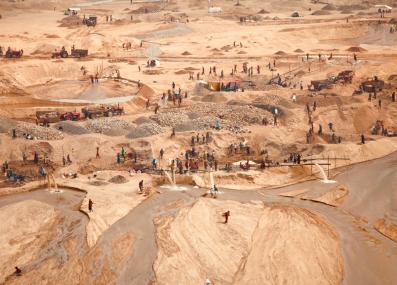Have a question?
How does the environmental impact of mining for clean energy metals compare to mining for coal, oil and gas?
Mining, whether for fossil fuels or metals used in clean energy technologies, has serious environmental impacts, and it’s hard to make apples-to-apples comparisons—except in terms of their impact on climate change, where clean energy mining is clearly better.
May 8, 2023
Building clean energy technologies, like wind turbines and electric vehicles (EV), is generally more mineral intensive than using fossil fuels.1 An EV requires six times more minerals than a conventional car (not counting steel and aluminum),2 while building a wind plant uses nine times more minerals than a gas-fired plant.3
Certain materials are particularly critical for the clean energy transition. These include lithium used in the batteries that run EVs, rare earth minerals in the magnets that allow wind turbines to make electricity, and copper, which is used for electricity transmission.
“The argument could be made that, with the clean energy transition, we’re exchanging a fossil fuel-based energy system with a metals-based energy system,” says Scott Odell, a visiting assistant professor of geography at George Washington University and visiting scientist at the MIT Environmental Solutions Initiative specializing in clean energy and mining.
As the clean energy transition moves forward, the demand for these materials will grow. Projections from the International Energy Agency (IEA) suggest that by 2040 the demand for copper could more than double, while the demand for lithium could grow over 40 times—if, that is, the world builds enough clean energy to meet the international climate goals set by the 2015 Paris Agreement.1
This growing demand will mean more and larger mines, which come with real risks to communities and to biodiversity.4 So is the direct impact of all this mining for clean energy greater or smaller than the impact of mining for fossil fuels?
That answer, unfortunately, isn’t straightforward. Odell explains that making an apples-to-apples comparison is challenging, because methods for extracting and processing oil and coal are different than those for metal mining. Even mining two different metals—or two different deposits of the same metal—can call for different techniques. “I think if someone were to tell you one or the other is better in terms of direct impacts pound for pound, you should ask a lot of questions about how they got to that answer,” says Odell.
We shouldn’t discount the amount of resource extraction we already do to power our current, climate-warming energy system. The volume of fossil fuels we mine today dwarfs the amount of clean energy minerals the world will need in the future. In 2021, over 7.5 billion tons of coal were extracted from the ground,5 while the IEA projects that the total amount of minerals needed for clean energy technology by 2040 will be under 30 million tons.1
Yet even this becomes complicated when one factors in the percentage of material extracted from a mine that is actually the usable resource we want. For coal, this number can range from less than 40 to as high as 90 percent.6 In contrast, Odell explains, this number for a copper deposit may be less than one percent, meaning that much more material needs to be extracted and processed for the same volume of output.
But there is one area where clean energy definitely wins out: climate-warming carbon dioxide (CO2) emissions. The emissions created by extracting minerals from the ground are tiny compared to those created by burning fossil fuels: a 2020 report from the IEA found that for every gigawatt of a clean energy technology that’s installed, millions of tons of CO2 emissions can be avoided.7
Given the urgent threat of climate change, Odell says the clean energy transition is necessary. However, he cautions that we must be aware of the environmental and social impacts of mining for clean energy materials. “What I worry about is, if we don’t solve climate change with an eye towards environmental justice, we could create more social and environmental crises for ourselves down the road. So we have to do it carefully, contemplatively and intelligently.”
Odell believes that the way forward for clean energy mining is through three main changes. The first is to reduce consumption so we need fewer materials in the first place, such as by investing in more public transportation and walkable cities, which would reduce the need for mineral-intensive EVs. The second is to advance the circular economy, reusing minerals instead of mining new ones. “There are a lot of metals already in the system and at the end of their lifespan, we send a lot of those to the dump,” he says.
Reducing consumption and improving recycling, however, won’t fill all of the demand for clean energy minerals. “We’re still going to need to do some digging,” says Odell. So the third change we need is to raise industry standards and adopt regulations to make sure mining is done in a more environmentally and socially responsible way.
1 International Energy Agency: "The Role of Critical Minerals in Clean Energy Transitions." Executive summary. Accessed May 8, 2023.
2 International Energy Agency: "Minerals used in electric cars compared to conventional cars." Updated October 26, 2022.
3 International Energy Agency: "Minerals used in clean energy technologies compared to other power generation sources." Updated October 26, 2022.
4 Sonter, Laura, et al. "Renewable energy production will exacerbate mining threats to biodiversity." Nature Communications 11 (September 2020), doi:10.1038/s41467-020-17928-5.
5 International Energy Agency: "Global coal production, 2018-2021." Updated October 26, 2022.
6 U.S. Energy Information Administration: U.S. Coal Reserves. October 18, 2022.
7 International Energy Agency: "Sustainable Recovery." July 2020.










